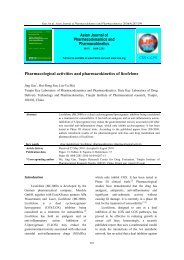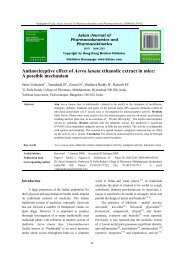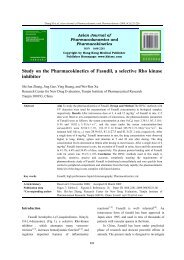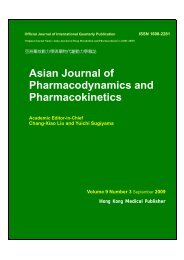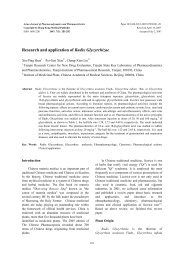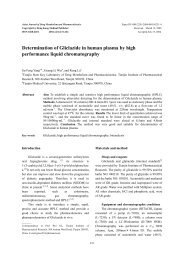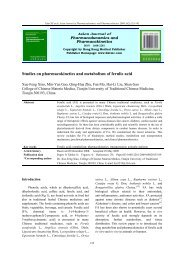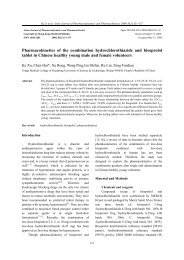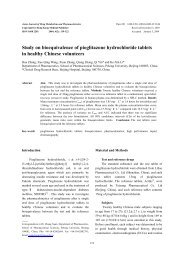Asian Journal of Pharmacodynamics and Pharmacokinetics
Asian Journal of Pharmacodynamics and Pharmacokinetics
Asian Journal of Pharmacodynamics and Pharmacokinetics
Create successful ePaper yourself
Turn your PDF publications into a flip-book with our unique Google optimized e-Paper software.
Cheng TF et al. <strong>Asian</strong> <strong>Journal</strong> <strong>of</strong> <strong>Pharmacodynamics</strong> <strong>and</strong> <strong>Pharmacokinetics</strong> 2009; 9(1):27-49<br />
already on the market. [43]<br />
The nanomedicine research is a goal <strong>and</strong> needs a<br />
long-term plan, which is to quantitatively<br />
characterize the molecular-scale components, or<br />
nanomachinery, <strong>of</strong> living cells <strong>and</strong> to precisely<br />
control <strong>and</strong> manipulate these molecular <strong>and</strong><br />
supramolecular assemblies in living cells to improve<br />
human health. Nanomedicine will exploit <strong>and</strong> build<br />
upon other research findings in nanotechnology <strong>and</strong><br />
apply it to the study <strong>of</strong> molecular systems in living<br />
cells that contain a multitude <strong>of</strong> nanoscale structures,<br />
such as membrane transporters, processes such as<br />
self-assembly <strong>of</strong> protein–nucleic acid complexes, <strong>and</strong><br />
nanomachines such as molecular motors. The<br />
benefits <strong>of</strong> nanomedicine include dramatically<br />
exp<strong>and</strong>ed knowledge <strong>of</strong> the human genome, a greater<br />
underst<strong>and</strong>ing <strong>of</strong> the pathophysiology <strong>of</strong> specific<br />
diseases at the molecular scale, more specific<br />
treatment <strong>of</strong> diseases, <strong>and</strong> the ability to underst<strong>and</strong><br />
the dynamic behavior <strong>of</strong> dysfunctional cellular<br />
machinery in the context <strong>of</strong> the total cell<br />
machinery. [44] Robert A <strong>and</strong> Freitas Jr given an<br />
overview <strong>of</strong> this rapidly exp<strong>and</strong>ing <strong>and</strong> exciting<br />
nanomedicine field. Over the next 5 to 10 years,<br />
nanomedicine will address many important medical<br />
problems by using nanoscale-structured materials <strong>and</strong><br />
simple nanodevices that can be manufactured today.<br />
Many approaches to nanomedicine being pursued<br />
today are already close enough to fruition that it is<br />
fair to say that their successful development is almost<br />
inevitable, <strong>and</strong> their subsequent incorporation into<br />
valuable medical diagnostics or clinical therapeutics<br />
is highly likely <strong>and</strong> may occur very soon. [45]<br />
The science <strong>of</strong> nanomedicine exploits <strong>and</strong> builds<br />
upon novel research findings in nanotechnology,<br />
biology, <strong>and</strong> medicine; it unifies the efforts <strong>of</strong><br />
scientists, engineers, <strong>and</strong> physicians determined to<br />
apply their latest research results to translational <strong>and</strong><br />
clinical medicine by developing novel approaches<br />
<strong>and</strong> a better underst<strong>and</strong>ing <strong>of</strong> solutions to<br />
health-relatedissues, ultimately improving the quality<br />
<strong>of</strong> life. The last few years have seen unprecedented<br />
advances in the field <strong>of</strong> biology. The decoding <strong>of</strong> the<br />
human genome coupled with improving gene<br />
transfection technologies <strong>of</strong>fer great opportunities for<br />
treating illnesses. In analysis <strong>and</strong> diagnosis,<br />
lab-on-a-chip methods have surpassed earlier ex-vivo<br />
<strong>and</strong> in-vivo detection methods while also aiding<br />
toxicology efforts. In medicine, improvements in<br />
targeted drug delivery, imaging, <strong>and</strong> therapy have led<br />
to such successful interventions in cancer therapies.<br />
[46]<br />
Although there are only a few FDA-approved<br />
nanopharmaceuticals on the market today, these<br />
formulations are already impacting medicine <strong>and</strong><br />
promise to alter healthcare. Based on their ability to<br />
reduce time-to-market, extend the economic life <strong>of</strong><br />
proprietary drugs <strong>and</strong> create additional revenue<br />
streams, nanopharmaceuticals should greatly impact<br />
medical practice <strong>and</strong> healthcare. However, if this is to<br />
happen effectively, there are a few key biological<br />
requirements for nanopharmaceuticals to fulfill: (1)<br />
they must exhibit stealth qualities to evade<br />
macrophage attack <strong>and</strong> the immune response; (2) be<br />
nontoxic <strong>and</strong> traceable; (3) display effective<br />
pharmacokinetic properties; (4) be biodegradable<br />
following systemic administration through any route<br />
(but the polymer must protect the embedded active);<br />
<strong>and</strong> (5) they must be selective to be effective in<br />
targeting specific tissue sites. Srikumaran Melethil<br />
(Chair <strong>and</strong> Pr<strong>of</strong>essor <strong>of</strong> Pharmaceutical Sciences at<br />
the University <strong>of</strong> Findlay, Findlay, OH) discussed the<br />
metabolic fate <strong>of</strong> nanopharmaceuticals upon delivery<br />
to the human body, <strong>and</strong> presented pharmacokinetic<br />
data relating to numerous nanoparticulate drugs <strong>and</strong><br />
highlighted the critical role <strong>of</strong> the FDA in<br />
nanomedicine. According to him, further knowledge<br />
<strong>of</strong> how the human body transports, distributes <strong>and</strong><br />
clears nanoparticles via the vascular <strong>and</strong> lymphatic<br />
systems (i.e.,biodistribution <strong>of</strong> nanoparticles) is also<br />
needed to get a h<strong>and</strong>le on metabolic <strong>and</strong> toxicity<br />
issues. Nanomedicine will eventually become an<br />
integral part <strong>of</strong> mainstream medicine <strong>and</strong> a st<strong>and</strong>ard<br />
in the drug industry. For example, the market impact<br />
<strong>of</strong> nanopharmaceuticals on the pharmaceutical <strong>and</strong><br />
biotech industries is already being felt. However, for<br />
nanomedicine to be a viable commercial entity,<br />
desperately needed reforms to overhaul the PTO<br />
along with clearer regulatory guidelines <strong>and</strong> safety<br />
st<strong>and</strong>ards from federal agencies such as the FDA will<br />
be needed.<br />
Ethical question <strong>of</strong> nanomedicine is an important<br />
issue. Ginger Gruters (The President's Council on<br />
Bioethics, Washington, DC) presented on ethical<br />
considerations that are likely to play a significant role<br />
in nanomedicine, <strong>and</strong> stated that, as with other<br />
43



